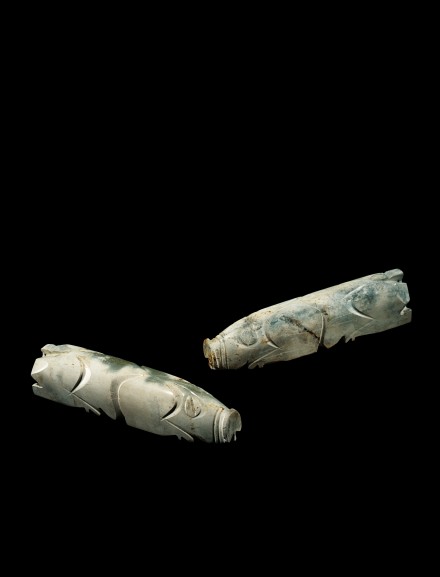J.J. Lally & Co., Oriental Art / New York City, New York
Menu
66.
A PAIR OF GREEN JADE PIGS
Western Han Dynasty (206 B.C. – A.D. 8)
each very simply carved from a solid block, the legs and feet delineated by deep slash cuts and notches, the pointed ears laid back flat on the sides of the head, the blunt snout with a small pierced tab at the base, the flat rump with a thick pierced tab for the tail, the translucent celadon green stone with creamy white areas and with remains of iron-rust and earth lightly encrusted on the polished surface.
Length 4 1⁄2 inches (11.5 cm) each
The custom of placing a pair of pigs (a banquet food) in the hands of the deceased is thought to have been done with the auspicious intent that there should be good food “in hand” at all times.
A similarly modelled pair of pigs in the collection of the Harvard University Art Museums is illustrated by Loehr, Ancient Chinese Jades from the Grenville L. Winthrop Collection in the Fogg Art Museum, Harvard University, Cambridge, 1975, p. 387, no. 555, where the author cites a very similar example found in an early Eastern Han tomb at Beizhuang, Dingxian, Hebei assigned to the period A.D. 56-88 on the basis of epigraphic evidence, illustrated in Kaogu Xuebao, 1964, No. 2, p. 148, fig. 4.
Another pair of Han pigs carved in a very similar style from mottled jade is illustrated by Rawson, Chinese Jade from the Neolithic to the Qing, London, 1995, pp. 319-320, no. 24:10. See also the very similar Han pig in the collection of the Tianjin Museum, illustrated by Bai (ed.) in Tianjin bowuguan cang yu (Jade Wares Collected by the Tianjin Museum), Beijing, 2012, p. 112, no. 095. Compare also the jade pigs of this type carved in the same classic style, sometimes referred to as ‘Han Eight Cuts’, illustrated in the catalogue of special exhibition at the Hong Kong Museum of Art, Chinese Jade Animals, Hong Kong, 1996, pp. 68-69, nos. 36-38.
Jade pigs were used in burials throughout the Han and Six Dynasties period. In Chinese Jades from Han to Ch’ing, Asia Society, New York, 1980, p. 45, James Watt illustrates a single jade pig from the collection of Laurence Sickman and cites a pair of jade pigs excavated from a tomb in Xuzhou, Jiangsu province which has been attributed to the end of the third century B.C., illustrated in Kaogu, 1974, No. 2, p. 121 as the earliest example of jade pigs recorded by archaeologists in China.
西漢 玉豚一對 各長 11.5 厘米
66.
A PAIR OF GREEN JADE PIGS
Western Han Dynasty (206 B.C. – A.D. 8)
Length 4 1⁄2 inches (11.5 cm) each